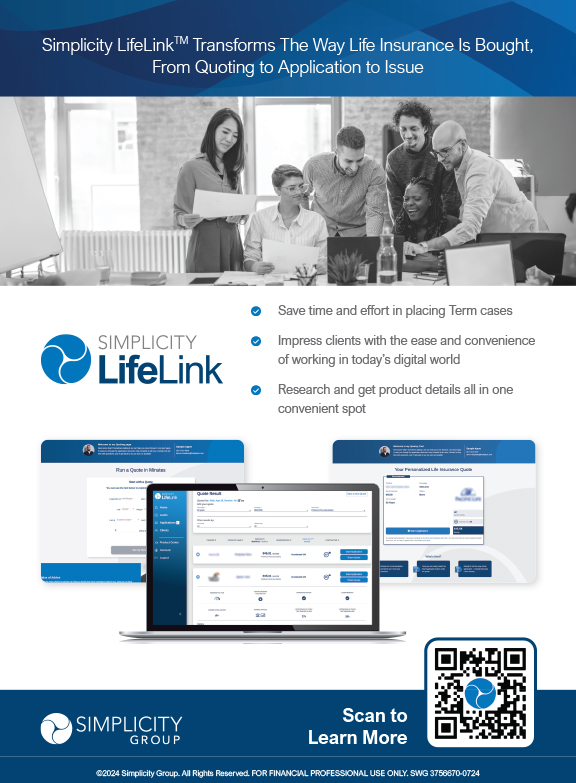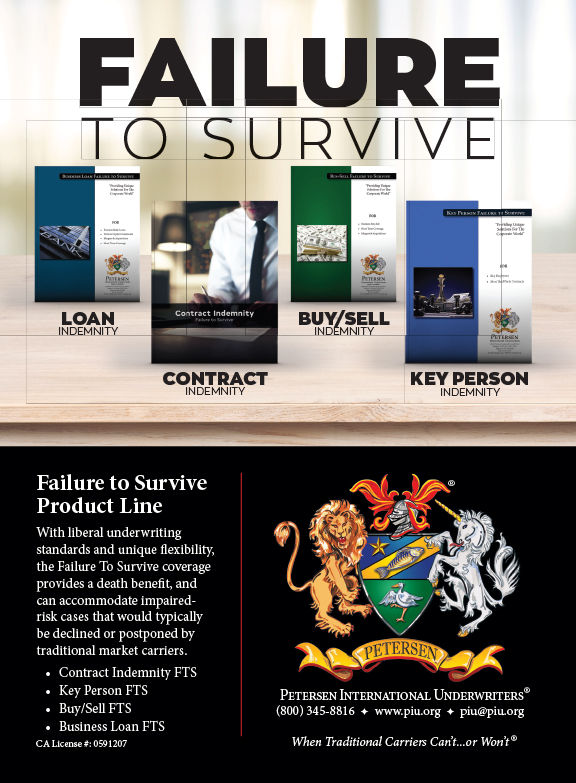“The LTC claim Process may ultimately become a challenge to our cherished fiduciary responsibilities.”
The results of all our attempts to include future planning for quality care giving as an integral component of our practice could become moot. It is and has always been our projected mission. It was always somewhat of a visionary crusade detailing and expounding on what a more predictable, financially prepared quality future care would look like. Those remaining LTCI specialists rightfully continue to view their activities as a sacred trust. For over a quarter of a century we have been filling as many sandbags as circumstance would allow with reserve claim dollars. We were that proverbial diligent squirrel who packed as many nuts in his mouth as possible to put them back for that almost certain rainy day. We repeatedly outlined a complete care story beginning and end. A story that celebrates with an induction into the LTCI or Chronic Illness policy ownership brigade. It then hopefully concludes with all our hard work performing as anticipated during what we always believed would be a period of quality, judicial, caring claim management. This is what we sold, and it is what we expect. Unfortunately, there are voices in the wind both from insureds and agents caught up in a claim adjudication “Process” suggesting that perhaps our expectations could be falling short. Please do not misunderstand, protecting the integrity and validity of all claim payments remains the primary focus of all those companies who have in the past or now continue to help us build those crucial insurance firewalls. Fraudulent claims must continue to be exposed and discarded. Ultimately there are an abundance of moving parts in the life of an LTC/Chronic Illness policy and as is often suggested the only variable susceptible to constant improvement is “Service.” As you might imagine this can represent a fairly sensitive conversation. Not unlike the social and cultural requirement of the father to daughter or mother to son conversation about the performance of the “birds and the bees.” This delicate and potential industry embarrassment may be perceived as a conversation reserved only for impolite company. Therefore, let us begin with what we know:
- No one would deny that the shorter the claim duration the smaller the ultimate cost. That LTC claims are occurring in an accelerated mortality environment. We all understand that those now attempting to access their policy benefits are in urgent need of relief.
- No one would deny that 90+ percent of all existing LTCI stand-alone premium resides in a closed block of health premium that will inevitably be subject to rate spiral propensities. This is also occurring in an environment of historical premium that was innocently underpriced for much of its early history.
- Every one should understand that disability income and stand-alone long term care insurance are at the very least kissing cousins. We cannot ignore and we must acknowledge that the fair and judicial payment of DI claims has had a long and very unflattering history. In 2003 DI companies were fined $181.5 million in punitive damages. Across America current plaintiff attorneys are loudly suggesting similar bad faith activities in the rapidly growing world of LTCI claim management.
- We must begin to acknowledge the size of the problem we are facing. It is currently projected that those 65 and older will outnumber our children in 2030. According to a 2024 survey of family caregivers conducted by seniorliving.org, 53 million family caregivers are currently assisting older relatives, spouses, friends or neighbors. One in five Americans are at this moment already plunged into the extraordinary demands of needed custodial care.
- The reality we must take to heart is that most of these circumstance recruited helpers are unpaid. According to the AARP Public Policy Institute we incur $600 billion in unpaid labor costs from family caregivers. Unprepared and unfunded caregiving has proven to dramatically increase the caregivers personal financial cost, emotional stress, personal health and well-being. The overall parameters of the problem could not be clearer. Intentionally choosing a future of unpaid family care regardless of your financial circumstance should always be your last choice.
- Approximately two thirds of the cost of senior care is paid as a function of government sponsored social insurance both Medicaid and a growing dynamic attributed to HHC from Medicare. It’s the one third of care funding that is sourced from private pay dollars that defines our risk sharing universe. The inescapable truth remains, if you can afford to pay for your additional care you will either pay from current assets or you have carefully and strategically planned ahead by acquiring additional funding support from a variety of insurance options.
- Rest assured insurance funding for claims is in place. According to the recent ATI Advisory, “Those who bought their policies in 1995, 2000, 2005 by 2020 there remained $28, $72, and $117 billion in benefit value for policy holders.” Determining over time if those carefully managed claim reserves prove entirely adequate as the generation of insured boomers approaches their most crucial caregiving years remains an industry mystery. According to The American Association for Long Term Care the industry paid out more than $14 billion in claims last year.
It was never a secret that LTC claims, if preceded at the time of sale with clean health input, would not generate substantial claims initially. The corollary understanding is that when they did appear, if sold to our preferred mid 50’s buyer, proud residents of the boomer generation now approaching their 80’s would then appear in relative abundance exactly as projected. Therefore now stepping from the dark shadows of uninitiated LTC liabilities into the bright lights of anticipated claims will demand the full attention of all those who participated in LTCI sales past, present and future. We are all in this together. We have all come to realize the LTC claim “Process” may ultimately be a challenge to all our cherished fiduciary responsibilities. Frankly, without any real understanding of the Process we are often being asked by our most valuable clients to help as claims begin to occur more often. We are being forced outside our comfort zone to try to assist with the establishment of new claim acceptance and ultimately a successful claim payment.
To open the velvet, claim curtain and be met by timely and fair claim illumination requires, in my humble opinion, knowledgeable professional help. You will need help with an abundance of complicated paperwork. You will need advice concerning medical assistance for a satisfactory plan of care. You will need guidance to scan for cognitive complications. Most importantly you will need knowledgeable, experienced assistance recommending customized care specific and unique to the clients personal desires.
Our clients deserve the smooth insurance justice we promised at the beginning of this insurance journey. Frankly, dear friends, you need professional help. Please look now for a connection to an experienced senior care agency advisor. Someone available immediately to help your insureds plan extensively for the cost of care associated with emotional, physical and health issues.
Aging at home or helping to transition to higher levels of care can be more easily achieved with the assistance of quality well-trained care experts. Our claim service future is open and malleable. Boomers’ claims are coming. Partnering with dedicated professionals who can help facilitate the peace of mind we set out to create 30 years ago can move us much closer to the fulfillment of the journey we promised.
Other than that I have no opinion on the subject.




































Preemptive Strike
There is indeed a major storm brewing just off shore. A financial and emotional conflagration of enormous proportions. A tsunami of claims that will be attributed to our perpetually discussed, most famous, favorite potential insurance and asset protection sales prospects, the beloved boomers. They have come full circle. They are on the verge of turning 80+ in mass. All those involved in the struggle to build fire walls around personal wealth for the last 30 years know or suspect the truth about our condition of readiness. We are simply unprepared, understaffed, uninsured, underinsured, unavailable and most importantly unaware that when the inevitable hits the shore our claim management first line of defense may be swept offshore.
We all need a new mental image to remind us of the reality of a new world where the primary focus is rapidly shifting from sales to claims. Perhaps the classic image of a snake eating its tail could be tattooed on our chests. The boomers who 20 to 30 years ago were standing around a claim fire watching their parents and loved ones, witnessed the struggle for a footing in the quest for quality care. Those who were at that time witnesses understood not just the need for care but the need for quality individually personalized care. Time has passed, inflation has done its damage, innocently ill-conceived pricing assumptions have been exposed, and perhaps most importantly the seismic shift from facility institutional confinement to enhanced, managed and monitored home care.
The parameters of the problem should be fixed permanently in your mind. We have over 7 million insureds and my guess would be that less than 10% of those standalone LTCI health policies were purchased in the last 10 years. I would also suspect that over 90% of those policies on the books are actually in closed blocks. Regardless of how well originally underwritten, these large reserves of money established for future claims will to some degree be subject to the forces of a classic rate spiral situation perhaps impacting the longevity of those reserves. l would also suspect the overwhelming majority have survived substantial rate increases as well as the relocation of their policy administration from the home office that sold them the policy to a claim management TPA.
Perhaps the two most important considerations at this time in our market’s history are our reliance on the mandatory diligence of those contracted administrators to prevent fraud, and that all concerned remain vigilant in our efforts to ensure timely and fair administration of those claims. Billions of dollars of reserves are currently in place for those with the foresight to have leveraged that expense with insurance dollars. On the other end of the financial spectrum, discounted funding primarily from Medicaid will ultimately provide some level of basic care.
Let’s establish some goal posts for subsequent columns beginning by trying to sort out the confusion surrounding some of the terminology at play in the marketplace.
What you will all need is direct experienced claim management for family and heirs. Your own exclusive personalized claim ombudsman and personal claim advocate. Someone trained to coordinate with an already established financial plan. Someone with the time tested knowledge to coordinate all the moving parts of an effective and efficient claim management process.
Frankly you need someone who takes a comprehensive approach to the problem providing needed support to all the family members involved.
Forgive me for stepping briefly out of the politically neutral line. My unsolicited but heart felt personal recommendation for just such an organization is AMADA Senior Care that for 28 years has specialized in working with and consistently helping those of us of the insurance persuasion and has been successfully delivering the very benefits outlined above.
Other than that I have no opinion on the subject.